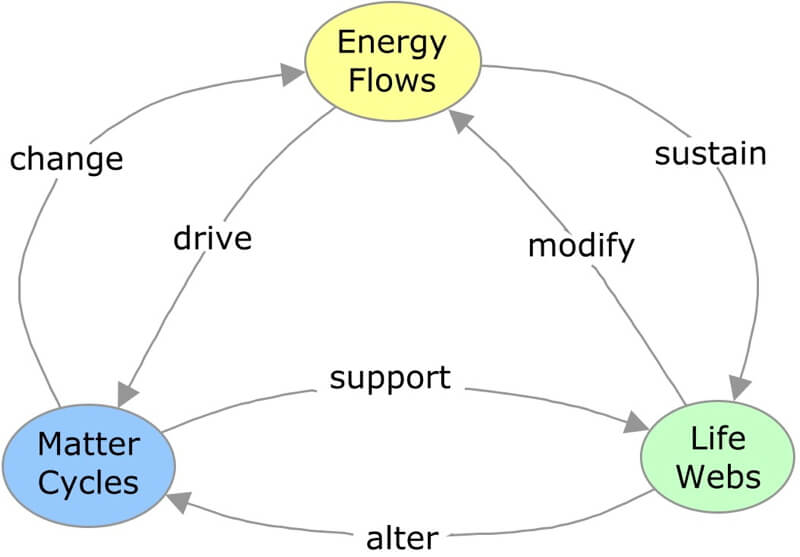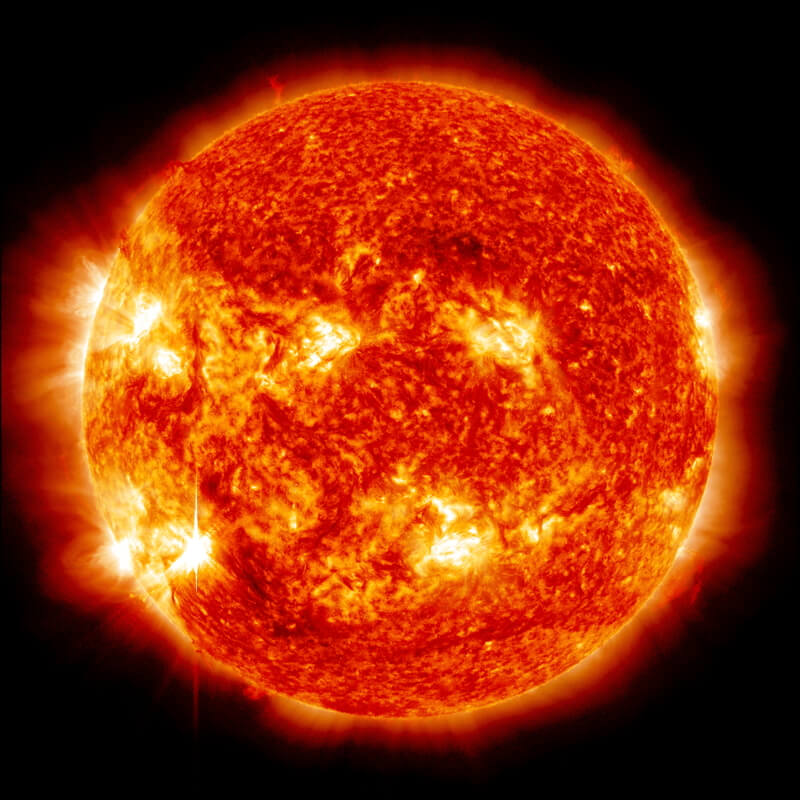Sun-Earth Connection
Earth is illuminated and warmed by our Sun, which, as with every star, is a self-contained spherical nuclear fusion reactor. The nuclei of lighter elements, predominantly hydrogen and helium plasma (the atoms are so hot they have lost their electrons), are slammed together within the Sun’s core and fuse to make heavier elements. A small portion of the mass of the fusing nuclei transforms into tremendous amounts of energy, which is calculated by:
e = mc²
where e = energy created, m = the amount of mass converted to energy, and c = speed of light.
The surrounding plasma transforms the energy of fusion to thermal energy, and the warmed material convectively rises to the Sun’s surface. As a result, the hot gas at the Sun’s surface emits proportionately large amounts of thermal radiation at shorter wavelengths; roughly 45% is visible light, 45% near-infrared, and 10% ultraviolet. For more information on stars, their formation, life cycle, and type, see this NASA article.
Radiation is a form of energy that travels well through the vacuum of space, and when it reaches Earth, our planet’s surface and atmosphere are illuminated and warmed. So Earth is heated by the energy released from a self-contained nuclear reactor 93 million miles away.
The Sun-Earth Connection section of Earth Systems explores the cyclical illumination and heating patterns of our planet, which drives many of Earth’s surface processes, particularly our weather, wind, and ocean currents. The affected energy flows and matter cycles support Earth’s life webs, so the Sun-Earth Connection plays an essential role in Earth’s systems. Plus, creatively using the Sun’s energy for human needs reduces (and hopefully eliminates) the demand for fossil fuels.

Concept map of the essential components of Earth systems and how they interact with each other.
There are three main subsections to the Sun-Earth Connection:
-
- Explore the patterns of Earth illumination as our spherical planet rotates and orbits our Sun.
- Examine the heating patterns across the Earth’s surface for a range of time and spatial scales.
- Learn to use a tool, declination circles, to visualize and calculate the intensity and duration of sunlight reaching the Earth’s surface at any time and day for any location on our planet.
Click on the following toggles to view descriptions and links of the web pages on each topic of the Sun-Earth Connection.
Sun-Earth Connection overview
An overview of how the Sun’s energy is generated and how its thermal radiation illuminates and heats Earth.
Earth Illumination Patterns
- Overview: The Sun illuminates the spherical, rotating planets orbiting it.
- Obliquity and Earth’s Illumination: Obliquity is the angle between the planes of the Earth’s equator and its orbit around the Sun.
- Declination, Latitude, & Earth Illumination: Solar declination is the angle between the Sun’s rays and the plane of the Earth’s Equator. Its value depends on where Earth is in its orbit around the Sun.
- Astronomical Seasons & Illumination: Astronomical seasons are based on the orientation of Earth’s axis of rotation to the Sun, which determines the amount of illumination between the Northern and Southern Hemispheres.
Distribution of the Sun's Energy on Earth
- Overview: Even though an area is illuminated by sunlight, there can be quite a range of energy interacting with the surface.
- Sun Angle and Beam Concentration: If every beam of sunlight reaching Earth has the same amount of energy, why do some areas warm up more than others?
- Diurnal Heating: Diurnal heating is the temperature change over 24 hours. When sunlight shines on the ground, it warms. Two critical factors that determine the amount of heating deal with the Sun’s illumination.
- Seasons: Earth experiences astronomical seasons due to its obliquity.
- Climate Regimes: Climate regimes are an extension of diurnal heating and seasons, but the time frame is now years.
Declination Circles: A tool to analyze the Sun's position in the sky.
- Overview: Drawings of declination circles contain the visual and numerical information to understand and predict the Sun’s motion across the sky.
- Declination Circles 101: Draw a declination circle with just a ruler and protractor/compass to quickly and accurately know the Sun’s position in the sky at any day and time of the year for any location on Earth.
- Drawing Declination Circles: Declination circles are quite easy to draw by hand.
- Interpreting Time on Declination Circles: Accurately estimate the time of day using the Sun’s location in the sky.
- Sunrise, Sunset, & Twilight: Calculate the timing and duration when the Sun is at or near the horizon.
- Solar Time, Angle, & Position: The sun’s angle and direction to the local horizon define the Sun’s position in the local sky. Explore how to use declination circles to calculate the Sun’s position at any solar time anywhere in the world on any day of the year.
- Changing Views of Declination Circles: Use the web app View Declination Circles to explore three common views of declination circles to identify their strengths, limitations, and applications. Then learn how to go from one view to another.
- Using Declination Circles: Humans have been using the apparent motion of the Sun as a compass, clock, and calendar for millennia.
- Using Sundials: Humans have been using the Sun’s position to navigate and tell the time, day, and season for millennia. Sundials create shadows that make it easier to do these tasks.


0 Comments